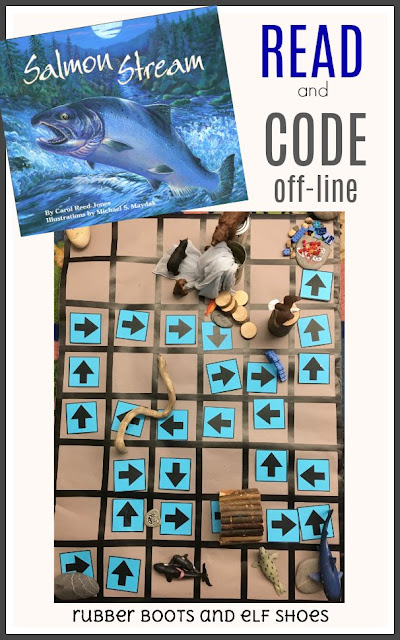Salmon are amazing creatures.
Any creature who jumps up waterfalls in order to get back to their birthplace is worth learning about.
Salmon Stream by Carol Reed-Jones is an ideal picture book to help young children learn about the life cycle of the salmon.

Salmon Stream
author: Carol Reed-Jones
illustrator: Michael S. Maydak
publisher: Dawn Publications, 2001
awards
Learning Magazine Teachers’ Choice Award
CBC/NSTA Outstanding Science Trade Book
summary Fast-paced prose and brilliant illustrations follow the salmon from their form as eggs in a stream to the wide ocean, eventually making a hazardous journey home to their stream of origin. As in her earlier best-selling book, The Tree in the Ancient Forest, author Carol Reed-Jones uses cumulative verse--a literary technique that is not only enjoyable but suggests how interconnected salmon are with their habitat. At the back is a section on salmon facts and what makes a good habitat for them, teaching the basics of ecology and why clean streams and waters are so important. -- Dawn Publications
from Dawn Publications: https://dawnpub.com/activity/salmon-stream-activities/
After reading the book, we got ready to code our friendly salmon from the ocean back to the stream where she was born, so that she could lay her eggs (and die).
We got our our coding grid.
I made it out of a heavy piece of paper and marked the squares with electrical tape.
Before we could code our fish "home", we had to create the journey.
What would be in between the ocean and her gravel bed -- the kids really wanted a waterfall, fish ladders, a tunnel/culvert.
How could we represent a waterfall, or fish ladders? Loose parts to the rescue. The kids made a lego fish ladder, and a blue scarf and tin cans became a waterfall. Driftwood and building blocks completed the "obstacles".
Then we started talking predators. Kindergarten kids can be pretty blood thirsty! But it made for more interesting coding, so ... we had a mama bear and 2 cubs, an eagle, a couple orca, a seal and a shark. The kids were a bit frustrated that the ocean animals had to stay in the ocean. But we had to think like scientists.
Once the grid was all set up, we were ready to get our salmon to her spawning grounds.
We code with arrows. Click [here] to print the set that I made to go with the grid.
Each child had a turn to put an arrow on the grid to help our mama salmon get upstream.
After reading the book, we got ready to code our friendly salmon from the ocean back to the stream where she was born, so that she could lay her eggs (and die).
We got our our coding grid.
I made it out of a heavy piece of paper and marked the squares with electrical tape.
Before we could code our fish "home", we had to create the journey.
What would be in between the ocean and her gravel bed -- the kids really wanted a waterfall, fish ladders, a tunnel/culvert.
How could we represent a waterfall, or fish ladders? Loose parts to the rescue. The kids made a lego fish ladder, and a blue scarf and tin cans became a waterfall. Driftwood and building blocks completed the "obstacles".
Then we started talking predators. Kindergarten kids can be pretty blood thirsty! But it made for more interesting coding, so ... we had a mama bear and 2 cubs, an eagle, a couple orca, a seal and a shark. The kids were a bit frustrated that the ocean animals had to stay in the ocean. But we had to think like scientists.
Once the grid was all set up, we were ready to get our salmon to her spawning grounds.
We code with arrows. Click [here] to print the set that I made to go with the grid.
Each child had a turn to put an arrow on the grid to help our mama salmon get upstream.
There was lots of discussion how to best make the journey.
Sometimes a wrong turn was made, and we had to "debug" the code.
Just before our salmon was about to be coded to her spawning ground there was a shout - "eggs, we need red eggs". There was a bit of a scurry around the classroom as a gaggle of children looked around to see what could be salmon eggs. Red beads. Then we needed gravel. And still water.
Then we could finish our code.





















No comments